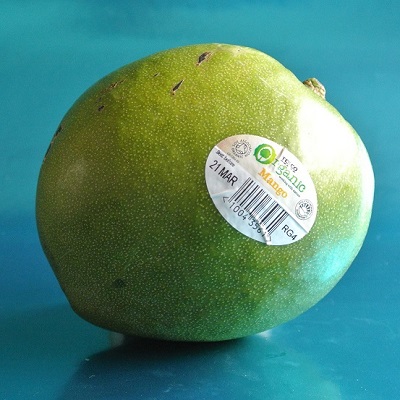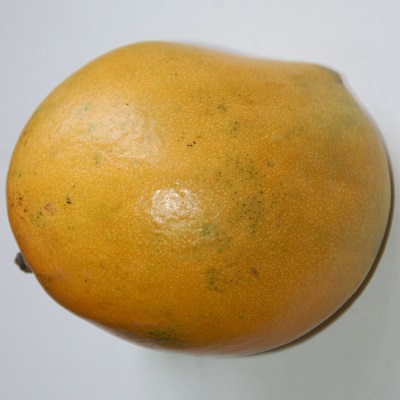Amélie is a green or pale-yellow skinned mango, sometimes with a red blush. It is a medium sized roundish fruit with a slightly prominent ‘nose’. It has a lovely flavour when harvested at the correct maturity and ripened well: quite a unique perfumed fragrance and background tang. The yellow flesh is silky smooth and fibreless.
Amélie is often sold as an Organic mango, as growing conditions in Burkina Faso, the main country of origin, are favourable to organic production.
Dried mango from West Africa is often produced using the Amélie variety.
Ripening: The peel of Amélie generally changes to a pale to mid-yellow when the fruit is ripe, but there needs to be an obvious softness to the fruit as well before eating. If slightly unripe, the flesh can be rubbery and slightly acidic. Unfortunately, the fruit is often harvested slightly early to accommodate sea-freighting to markets, so the flavour can be subdued.
Good Fruit Guide Rating: ****
When harvested at the right time, Amélie is a lovely mango with a unique perfumed flavour.
Fibreless, sweet, perfumed.
Names: Amélie; Reine- Amélie; Amélie de Martinique
Origin: The precise origin of Amélie is difficult to decipher, but it seems to have originally been distributed to the Caribbean from Mauritius in the 18th century. It’s introduction to Porto Rico from Jamaica is recorded as occurring in 1782 (*The Mango of Porto Rico by Guy M. Collins); thence to Mali in west Africa by catholic missionaries in 1890. Amélie became the most popular grafted variety in the region and spread from Mali through the upper Niger valley, western Burkina Faso, northern Côte d’Ivoire, Senegal and Upper Guinea. By the 1960’s, Amélie accounted for 99% of grafted mango in the Sudanian savannah region (*Jean-Yves REYa et al). This is no longer the case as more and more Kent and Keitt have been planted for export, but emphasises the popularity of the variety in the local region – always a good sign.
Grown in: Burkina Faso, Mali, Côte d’Ivoire, Senegal, Guinea
Harvest & Availability: Supplies of Amélie to the UK are generally as follows:
- January:
- February:
- March: Burkina Faso
- April: Burkina Faso
- May:
- June:
- July:
- August:
- September:
- October:
- November:
- December:
Websites:




Reviews
There are no reviews yet.